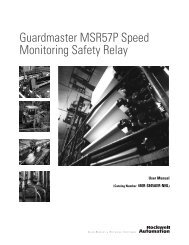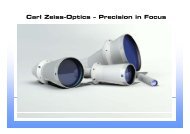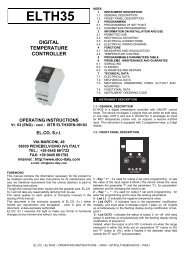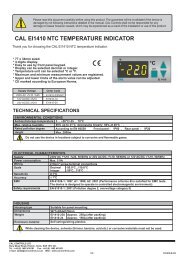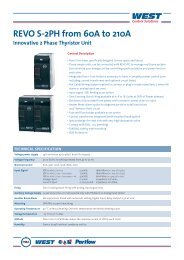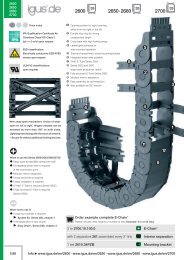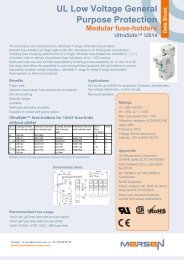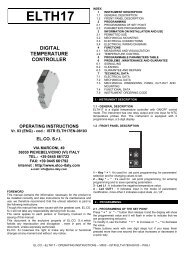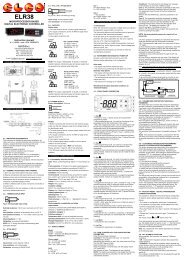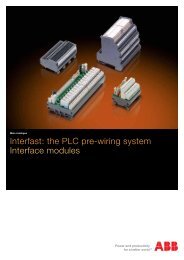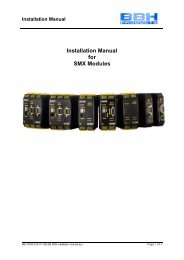P43-F4V-2D-1D0-180E | Page 1 - PIL Sensoren GmbH
P43-F4V-2D-1D0-180E | Page 1 - PIL Sensoren GmbH
P43-F4V-2D-1D0-180E | Page 1 - PIL Sensoren GmbH
You also want an ePaper? Increase the reach of your titles
YUMPU automatically turns print PDFs into web optimized ePapers that Google loves.
Pil <strong>Sensoren</strong> <strong>GmbH</strong> Hainstraße 50 D-63526 Erlensee<br />
Tel: 49 (0)6183 9109-0 Fax: 49 (0)6183 9109-55 E-Mail: info@<strong>PIL</strong>.de<br />
ISO 9001 zertifiziert<br />
<strong>P43</strong>-<strong>F4V</strong>-<strong>2D</strong>-<strong>1D0</strong>-<strong>180E</strong> <strong>Page</strong> 2<br />
Analogue output adjustment<br />
P1 and P2 define the analogue output slope.<br />
P1 determines the 0V position and P2 the 10V<br />
position.<br />
Positive slope: --> P1 < P2<br />
Negative slope: --> P2 < P1<br />
Analoge Kennlinie<br />
Mit P1 und P2 wird der Arbeitsbereich der<br />
analogen Kennlinie festgelegt: P1<br />
bestimmt die Position an der die Kennlinie<br />
den Wert 0V annimmt, P2 bestimmt die<br />
Position 10 V.<br />
Positive Kennlinie: --> P1 < P2<br />
Negative Kennlinie: --> P2 < P1<br />
Sortie analogique<br />
P1 et P2 définissent les deux limites de la<br />
sortie analogique du capteur.<br />
P1correspond à la limite 0V, Et le point<br />
correspond à la limite 10V.<br />
Pour obtenir une pente positive, il faut<br />
donc que P1 < P2<br />
Pour obtenir une pente négative il faut<br />
donc que P1 > P2<br />
Normal function:<br />
The Echo LED is ON when an echo is<br />
received (alignment LED). P1 and P2 LEDs<br />
are indicating status of the switching<br />
outputs.<br />
Normale Funktion :<br />
Echo LED an, wenn Echo empfangen wird<br />
(Ausrichthilfe). LEDs P1 und P2 zeigen<br />
Schaltzustände von SP1 und SP2 an.<br />
Fonctionnement normal du capteur:<br />
Le LED Echo sera allumé si un écho est<br />
reçu. Il s agit d un témoin d alignement.<br />
Les LEDs P1 et P2 indiquent l état des<br />
sorties à seuil.<br />
Normal switching function Normale Schaltfunktion Fonction à seuil normale<br />
Teach In of P1 (SP1 position)<br />
Connect Teach In line with GND until P1 and Echo LEDs<br />
start blinking with a 2 Hz frequency and then release the<br />
contact. The sensor is now in Teach In mode for P1: P1 LED<br />
will now blink with 1Hz frequency and the Echo LED will go<br />
back to normal function (alignment LED)<br />
There is a time window of 30 sec. to do the programming of<br />
P1<br />
Place the target at the new position P1.<br />
Contact and release Teach In line with GND: P1 is now<br />
programmed.<br />
Sensor returns into normal function with new value for P1.<br />
Switching output characteristics can be selected during teach<br />
in of the set points P1 and P2. For each set point and during<br />
the teaching procedure, when the LED is ON when<br />
contacting and releasing the teach in line to ground, the<br />
switching output will have NO characteristics, when doing<br />
this when the LED is it OFF, the switching output will have<br />
NC characteristics.<br />
Teach In Modus P1 (Position SP1)<br />
Teach-In Ausgang mit GND verbinden bis LEDs P1 und<br />
Echo anfangen mit ~2Hz zu blinken.<br />
Verbindung lösen: jetzt ist Sensor im Teach In Modus für<br />
P1: LED P1 blinkt mit ~ 1Hz; Echo LED normale Funktion<br />
(Ausrichthilfe)<br />
Innerhalb von 30 sec. muss P1 eingelernt werden!<br />
Objekt an neue Position P1 bringen<br />
Teach-In Ausgang kurz mit GND verbinden und lösen:<br />
P1 ist eingelernt. Sensor arbeitet jetzt in normaler<br />
Funktion mit neuem eingestellten Wert für P1.<br />
Charakteristik des Schaltausgangs<br />
Ist beim Einlernen des Schaltpunktes die LED P1 an, so<br />
hat der Schaltpunkt NO Charakteristik, ist sie aus, so ist<br />
die Charakteristik NC.<br />
Apprentissage de P1 (Position SP1)<br />
Connecter la sortie apprentissage (Teach In, pin5) avec<br />
la sortie masse (GND) jusqu'à clignotement des LEDs P1<br />
et Echo a une fréquence de 2Hz.<br />
Déconnecter la sortie apprentissage: le capteur est<br />
maintenant en mode 'programmation pour P1: LED P1<br />
clignote à une fréquence de 1Hz, LED Echo<br />
Retourne à sa fonction de témoin d'alignement. A ce<br />
moment, une séquence de 30 sec. commence pour<br />
effectuer la programmation de la position P1<br />
Placer l'objet à la nouvelle position désirée de P1.<br />
Connecter et déconnecter la sortie apprentissage (Teach<br />
In, pin5) a la masse (GND): P1 est maintenant<br />
programmé.<br />
Le capteur retourne après la procédure finie en fonction<br />
normale avec la nouvelle valeur pour P1 en mémoire.<br />
Choix entre sortie NO / NF<br />
Pour choisir une sortie NO ou NF, il suffit de connecter la<br />
ligne apprentissage (teach in, pin 5) pendant la<br />
procédure apprentissage de P1 lorsque le LED P1 est<br />
allume pour avoir une sortie NO ou lorsque le LED est<br />
éteint pour avoir une sortie NF.



